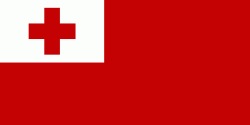Tongatapu
Tongatapu has experienced more rapid economic development than the other islands of Tonga, and has thus attracted many internal migrants from them.
The island is 257.03 km2 (or 260.48 km2 including neighbouring islands) and rather flat, as it is built of coral limestone. The island is covered with thick fertile soil consisting of volcanic ash from neighbouring volcanoes. At the steep coast of the south, heights reach an average of 35 m, and maximum 70 m, gradually decreasing towards the north.
North of the island are many small isolated islands and coral reefs which extend up to 7 km from Tongatapu's shores. The almost completely closed Fanga'uta and Fangakakau Lagoons are important breeding grounds for birds and fish as they live within the mangroves growing around the lagoon's shores. The lagoons were declared a Natural Reserve in 1974 by the government.
Map - Tongatapu
Map
Country - Tonga
 |
 |
| Flag of Tonga | |
First inhabited roughly 2,500 years ago by the Lapita civilization, Tonga's Polynesian settlers gradually evolved a distinct and strong ethnic identity, language, and culture as the Tongan people. They were quick to establish a powerful footing across the South Pacific, and this period of Tongan expansionism and colonization is known as the Tuʻi Tonga Empire. From the rule of the first Tongan king, ʻAhoʻeitu, Tonga grew into a regional power. It was a thalassocracy that conquered and controlled unprecedented swathes of the Pacific, from parts of the Solomon Islands and the whole of New Caledonia and Fiji in the west to Samoa and Niue and even as far as parts of modern-day French Polynesia in the east. Tuʻi Tonga became renowned for its economic, ethnic, and cultural influence over the Pacific, which remained strong even after the Samoan revolution of the 13th century and Europeans' discovery of the islands in 1616.
Currency / Language
| ISO | Currency | Symbol | Significant figures |
|---|---|---|---|
| TOP | Tongan paʻanga | T$ | 2 |
| ISO | Language |
|---|---|
| EN | English language |
| TO | Tongan language |















